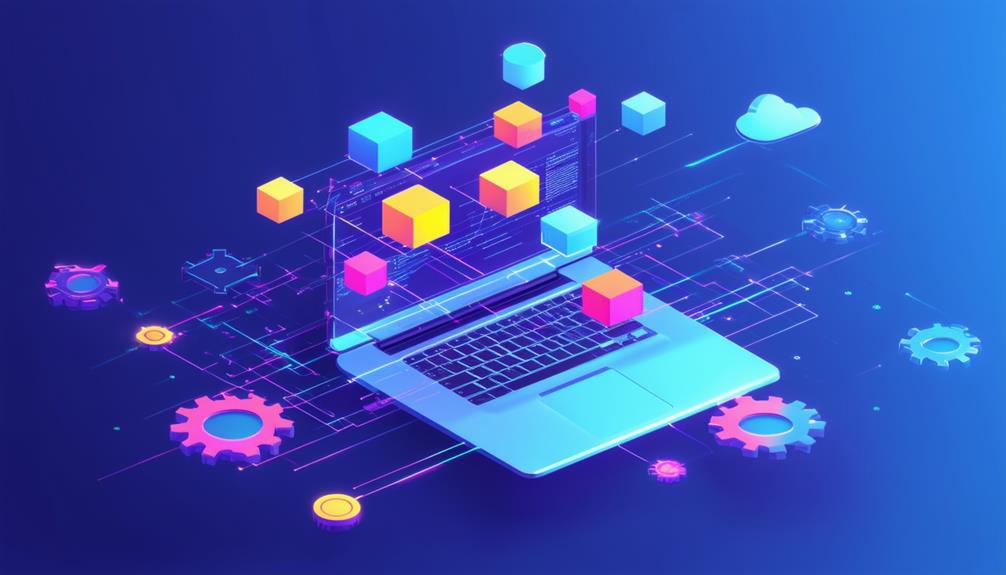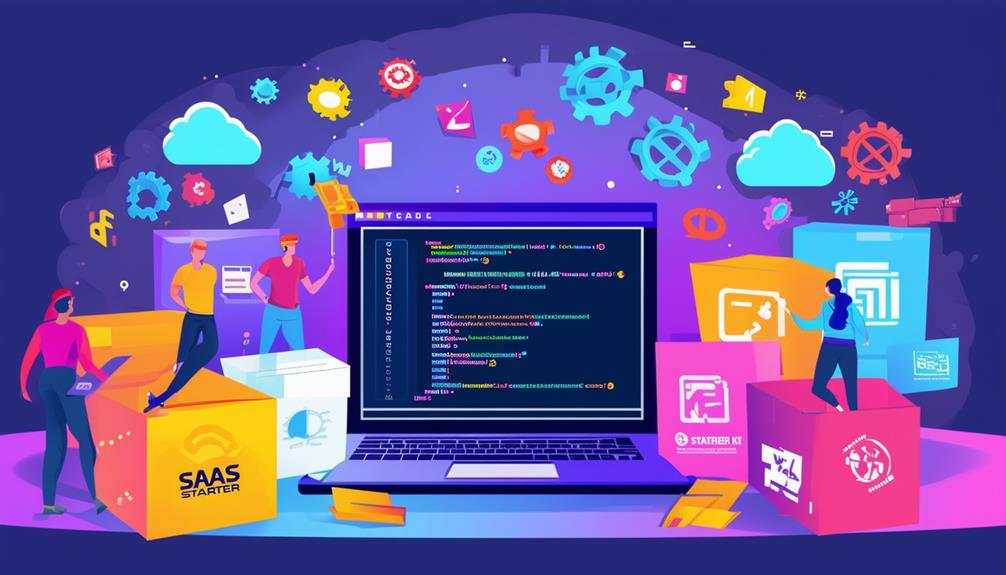When you’re building a scalable SaaS application, you don’t have to start from scratch. SaaS starter kits can be your secret weapon, offering pre-built components and best practices that’ll save you time and money. These kits typically include essential features like user authentication, database setups, and API frameworks. By leveraging a well-chosen starter kit, you’ll be able to focus on your unique value proposition instead of reinventing the wheel. But not all kits are created equal, and selecting the right one for your project is vital. To make the most of this powerful tool, you’ll need to understand the key factors that influence your choice.
Understanding SaaS Starter Kits
SaaS starter kits are pre-built software foundations that can dramatically accelerate your journey from concept to fully-functional SaaS product, saving you time, money, and development headaches. These kits typically include essential components like user authentication, billing systems, and basic UI elements, allowing you to focus on your unique value proposition.
By leveraging a SaaS starter kit, you’ll reduce development time by up to 70% and cut costs by an average of 60%. These kits often come with best practices baked in, ensuring your application is scalable and secure from the start. They’re designed to handle common SaaS requirements, such as multi-tenancy and subscription management.
When choosing a starter kit, consider factors like your tech stack, scalability needs, and customization options. Popular options include Django SaaS Boilerplate for Python developers, SaaSgear for Node.js enthusiasts, and Laravel Spark for PHP aficionados. Each offers different features and trade-offs.
Benefits of Using Starter Kits
While you might be tempted to build your SaaS product from scratch, leveraging a starter kit can offer numerous advantages that’ll propel your project forward more efficiently and effectively. These kits provide a solid foundation, saving you valuable time and resources in the initial development stages.
One of the primary benefits is accelerated time-to-market. Studies show that using starter kits can reduce development time by up to 40%. You’ll have a functional prototype ready in days rather than weeks or months. This speed allows you to validate your idea quickly and start gathering user feedback sooner.
Cost-efficiency is another vital advantage. By utilizing pre-built components, you’ll considerably reduce development costs. Research indicates that companies can save up to 60% on initial development expenses when using starter kits.
Moreover, these kits often incorporate best practices and industry standards, ensuring your application is built on a robust, scalable architecture. This foundation enhances your product’s reliability and maintainability, which is essential for long-term success.
Lastly, starter kits typically come with built-in features like user authentication, payment processing, and analytics. These necessary functionalities allow you to focus on developing your unique value proposition rather than reinventing the wheel.
Choosing the Right Kit
Selecting the ideal SaaS starter kit requires careful consideration of your project’s specific needs, technical requirements, and long-term goals.
Begin by evaluating your team’s technical expertise and the stack you’re most comfortable with. Popular options include MERN (MongoDB, Express, React, Node.js) for JavaScript developers or Django for Python enthusiasts.
Next, analyze the kit’s scalability potential. Look for features like containerization support, microservices architecture, and built-in load balancing. These elements will be essential as your SaaS grows.
Examine the kit’s documentation quality and community support. Active GitHub repositories and thorough guides indicate a well-maintained kit.
Consider the included features. Does the kit offer user authentication, payment integration, and basic CRUD operations out of the box? These can greatly speed up development.
However, make sure the kit isn’t bloated with unnecessary features that may slow down your application.
Common Features in Starter Kits
When exploring SaaS starter kits, you’ll typically encounter several key features designed to streamline your development process and accelerate time-to-market. These common components form the backbone of most starter kits, providing a robust foundation for your SaaS application.
Authentication and user management systems are often included, allowing you to quickly implement secure login, registration, and account recovery processes. You’ll also find pre-configured database setups, usually with ORM (Object-Relational Mapping) integration, enabling efficient data handling and storage.
Many kits offer API scaffolding, providing a structure for building RESTful or GraphQL APIs. This feature can greatly reduce the time spent on backend development.
Frontend frameworks and UI component libraries are frequently bundled, offering responsive and customizable user interfaces out of the box.
Subscription and billing management systems are essential for SaaS applications, and many starter kits include integrations with popular payment gateways. You’ll also find built-in analytics and monitoring tools to help you track user behavior and application performance.
Lastly, most kits come with deployment configurations for cloud platforms like AWS, Google Cloud, or Heroku, simplifying the process of launching your application in a production environment.
Customization and Extensibility
Flexibility is a key factor in choosing a SaaS starter kit, as you’ll need to customize and extend its features to fit your unique business requirements. Look for kits that offer modular architecture and well-documented APIs, allowing you to easily modify existing components or add new ones. These features enable you to tailor the solution to your specific needs without starting from scratch.
When evaluating starter kits, prioritize those with robust customization options. Seek out kits that provide theming capabilities, allowing you to adjust the UI to match your brand identity. Additionally, consider kits that support plugin systems, enabling you to integrate third-party tools or develop custom functionalities.
To guarantee long-term scalability, choose starter kits with clear upgrade paths and active developer communities. This approach will help you stay current with the latest technologies and best practices. Pay attention to the kit’s licensing terms, ensuring they allow for commercial use and modifications.
Scalability Considerations
Beyond customization, you’ll need to assess a SaaS starter kit’s ability to grow with your business, as scalability directly impacts your long-term success and operational efficiency.
When evaluating scalability, focus on three key areas: infrastructure, performance, and cost.
First, examine the kit’s infrastructure. Look for cloud-native architectures that leverage containerization and microservices. These technologies enable easier horizontal scaling as your user base grows. Verify the kit supports auto-scaling features to handle traffic spikes efficiently.
Next, assess performance metrics. A scalable starter kit should maintain response times under 200ms, even as load increases. Check if it includes caching mechanisms and database optimizations to handle high-volume data processing.
Finally, consider cost scalability. Analyze the kit’s resource utilization and how it translates to cloud expenses. Opt for solutions that offer pay-as-you-go models and allow for fine-tuning of resources to optimize costs.
Prioritize starter kits that provide detailed documentation on scaling strategies and offer benchmarking tools. This information will help you make informed decisions as you scale your SaaS application, confirming it can handle growth without compromising performance or breaking the bank.
Integration With Existing Systems
A essential factor in selecting a SaaS starter kit is its ability to seamlessly integrate with your existing tech stack and business systems. When evaluating potential kits, prioritize those offering robust API support and pre-built connectors for popular platforms. Look for kits that support industry-standard protocols like REST, GraphQL, and webhooks to guarantee smooth data exchange.
Consider your current CRM, ERP, or marketing automation tools. Does the starter kit offer native integrations or easy-to-implement plugins for these systems? This can greatly reduce development time and costs. Pay attention to authentication mechanisms, confirming the kit supports OAuth 2.0 or similar secure protocols for seamless user authentication across platforms.
Data synchronization capabilities are essential. Seek kits that provide real-time or near-real-time syncing options to maintain data consistency across your ecosystem. Additionally, evaluate the kit’s compatibility with your preferred hosting environment, whether it’s cloud-based or on-premises.
Lastly, consider the kit’s extensibility. Can you easily add custom integrations if needed? A flexible architecture that allows for modular additions will future-proof your application as your integration needs evolve.
Security and Compliance
When selecting a SaaS starter kit, prioritize robust security features and compliance capabilities to protect your data and meet regulatory requirements. Look for kits that offer end-to-end encryption, multi-factor authentication, and regular security audits. Confirm the kit supports compliance with industry standards such as GDPR, HIPAA, or PCI DSS, depending on your specific needs.
Implement role-based access control (RBAC) to restrict user permissions and minimize potential security breaches. Choose a kit that provides detailed activity logs and audit trails, enabling you to monitor and track user actions. Opt for solutions that offer automated backup and disaster recovery features to safeguard your data against loss or corruption.
Consider kits with built-in vulnerability scanning and penetration testing tools to identify and address potential security weaknesses proactively. Evaluate the kit’s update and patch management processes to confirm timely security fixes. Look for providers that offer extensive documentation on their security practices and compliance certifications.
Don’t forget to assess the kit’s data retention and deletion policies to maintain control over your information.
Performance Optimization Techniques
To maximize your SaaS application’s speed and responsiveness, you’ll need to implement key performance optimization techniques within your starter kit.
Start by optimizing database queries, using indexing and caching to reduce load times. Implement content delivery networks (CDNs) to serve static assets from geographically distributed servers, minimizing latency for global users.
Leverage lazy loading for images and components, guaranteeing that resources are only loaded when needed. Implement efficient code splitting and bundling strategies to reduce initial load times and improve overall performance. Utilize server-side rendering (SSR) for faster initial page loads and improved SEO.
Optimize your API calls by implementing rate limiting, pagination, and response compression. Use asynchronous processing for resource-intensive tasks to prevent blocking the main thread. Implement efficient memory management techniques, such as object pooling and garbage collection optimization.
Monitor your application’s performance using tools like New Relic or Datadog, identifying bottlenecks and optimizing accordingly. Regularly conduct load testing to guarantee your application can handle increased traffic.
Cost-Benefit Analysis
Conducting a thorough cost-benefit analysis helps you determine if leveraging a SaaS starter kit is the right choice for your project’s specific needs and budget constraints.
Start by calculating the upfront costs of purchasing a starter kit and comparing it to the expenses of building your application from scratch. Factor in development time saved, which can be substantial – often reducing project timelines by 40-60%.
Next, assess the long-term benefits. SaaS starter kits typically offer ongoing support and updates, potentially saving you 20-30% in maintenance costs annually. Consider the scalability advantages, as many kits are designed to handle increased user loads without significant redevelopment.
Evaluate potential drawbacks, such as customization limitations or vendor lock-in. Weigh these against the faster time-to-market and reduced development risks. Analyze your team’s expertise and determine if the learning curve for the starter kit is manageable.
Lastly, calculate the return on investment (ROI) by comparing projected revenue gains from earlier market entry against total costs. If the ROI is positive and aligns with your business goals, leveraging a SaaS starter kit could be a strategic move for your scalable application development.
To Wrap Up
By leveraging SaaS starter kits, you’ll accelerate your development process and reduce costs.
Choose a kit that aligns with your technical needs and scalability goals. Implement essential features, customize modules, and integrate with existing systems.
Prioritize security and compliance while optimizing performance. Conduct a thorough cost-benefit analysis to guarantee maximum ROI.
With the right starter kit, you’ll build robust, scalable applications that grow efficiently over time, giving you a competitive edge in the SaaS market.






